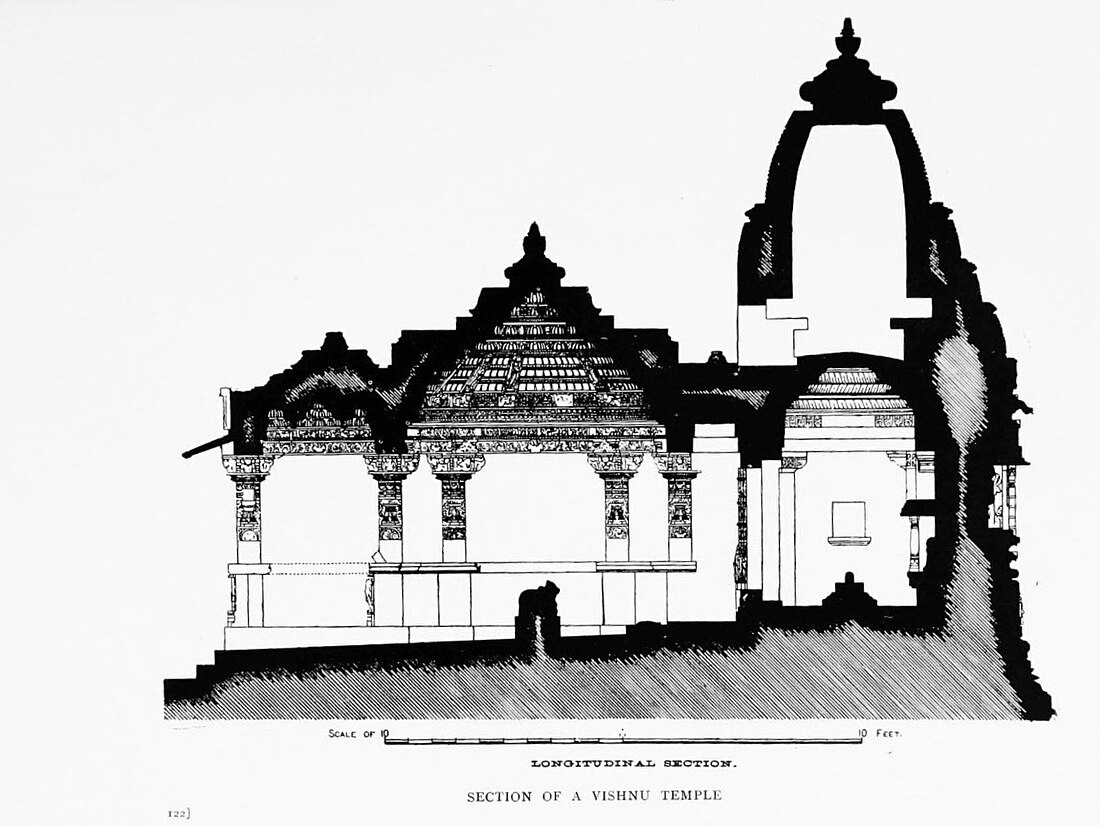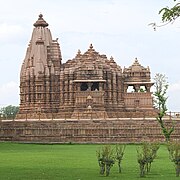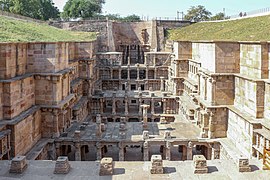Nagara Style
Hindu architectural style From Wikipedia, the free encyclopedia
Nagara Style or Nagara architectural style is a Hindu style of temple architecture, which is popular in Northern, Western and Eastern India (except the Bengal region[1]), especially in the regions around Malwa, Rajputana and Kalinga.[2] Temples classified as Nagara Style are found in Madhya Pradesh, Uttar Pradesh, Rajasthan, Uttarakhand, Himachal Pradesh, Gujarat, Odisha,[3] Jharkhand,[4] Bihar,[4] Maharashtra, Andhra Pradesh (areas bordering Odisha) and West Bengal (southwest and Sundarbans areas).

In fifth century, the use of simple curved Shikhara (spires) begins in the temples; the earliest such temples being classified as Early Nagara Style.[5] The Early Nagara Style was transformed into the Mainstream Nagara Style in the seventh century.[6]
This architectural style is one of the two main styles of Hindu temple architecture, the other being the Dravidian architectural style.[2] Nagara style has three sub-styles or schools, which differ slightly from each other. The sub-styles or schools are Orissa school, Chandel school and Solanki school.
Developed in North India, this style of temple is built on a simple stone platform. One or more Sikharas are observed in temples, but the earliest temples consist of only one Sikhara. The garbhagriha is always located directly below the highest Sikhara. Also, the Nagara Style is characterized by the absence of boundary walls, which are widely used in the Dravidian architectural style of Hindu temple architecture. Some temple complexs and individual structures in the Nagara Style are listed as UNESCO World Heritage Sites.[a]
History
Origin and formative stage
The Nagara temple style evolved from the Gupta structural temples. From about the 5th century onwards, the development of Nagara temple style began, which passed through three classes of formative stage and got its present form.[9]
Schools of Nagara Style
Summarize
Perspective
Nagara architectural style are observed in northern, western and eastern parts of India. Since its origin, this style has gone through various changes to its present form. Variations within the style have developed over time from region to region, which have come to be recognized as sub-styles. Nagara architectural style has three sub-styles namely Chandel, Solanki and Odisha sub-styles.
Chandela School
The Chandela School or Chandela sub-style of temple construction originated in Central India. It was developed by the Chandel dynasty, the rulers of the Bundelkhand region (then called Jejakabhukti).This school or sub-style of temple construction is also known as Khajuraho School or sub-style. Temples built in this style have intricate carvings, which adorn the inner and outer walls. The sculptures in the temple are known for sensual themes, which were inspired by Vatsyayana's Kama Sutra. Sandstones are mainly used in the construction of temples.[10]
- Vamana Temple
- Vishwanath temple
- Chitragupta temple
Solanki school
This Solanki school or sub-style originated in northwestern India, particularly in the present-day Indian states of Gujarat and Rajasthan. As this sub-style expanded and developed, the Solanki kings provided support and encouragement. The walls of the temple, built in the Solanki sub-style, were without sculptures. Inside and externally the garbhagriha and mandapa are interconnected. A terraced water tank, known as Surya Kund, is excavated next to temples of this sub-style. This sub-style has also come to be known as the Māru-Gurjara school or sub-style since the 20th century.[10]
- Rani ki vav, Patan, India
- Taranga Jain temple
- Front view of Navlakha Temple
Odisha School
The Odisha school or sub-style originated in the coastal regions of eastern India, especially the present Indian state of Odisha and Andhra Pradesh bordering Odisha. This school or sub-style of temple construction is also known as Kalinga School or sub-style.[11][12]
- Lingaraj Temple complex
- Panorama view of Konark Sun Temple
- Jagannath Temple, Puri
Notes
- The Khajuraho temple complex,[7] and the Konark Sun Temple[8] and Mahabodhi Temple[4] built in Nagara Style, which are recognized as UNESCO World Heritage Sites.
References
Bibliography
Wikiwand - on
Seamless Wikipedia browsing. On steroids.









